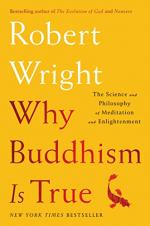
|
| Name: _________________________ | Period: ___________________ |
This test consists of 15 multiple choice questions and 5 short answer questions.
Multiple Choice Questions
1. The Buddah stated that what element is impermanent?
(a) Feeling.
(b) Life.
(c) Englightenment.
(d) Self.
2. On what body process should first-timers focus when meditating?
(a) Breath.
(b) Blood.
(c) Bile.
(d) Phlegm.
3. What is the English translation of the word anatta?
(a) Peace.
(b) Suffering.
(c) Not-self.
(d) Tranquility.
4. The author explains that the book Buddhism is True is an attempt to do all but which of the following things?
(a) To point out the window.
(b) To explain from a scientific standpoint why what lies beyond the door contains more reality than the one people have come to accept.
(c) To show people the door.
(d) To give people some idea of what lies beyond the door.
5. What is NOT one of the five aggregates named by The Buddha when he first split the self into five aggregates?
(a) Feelings.
(b) Longings.
(c) The physical body.
(d) Mental formations.
6. What is the title of Chapter 2 of Buddhism is True?
(a) Taking the Red Pill.
(b) Paradoxes of Meditation.
(c) When Are Feelings Illusions?.
(d) The Alleged Nonexistence of Your Self.
7. The author states that "More and more, groups of people define their identity in terms of" (17) what?
(a) Material wealth.
(b) Career.
(c) Sharp opposition to other groups of people.
(d) Family.
8. According to Buddhist scripture, what is the name of the braggart who challenged The Buddha's notions of not-self?
(a) Bhikkhu Bodhi.
(b) Thich Quang Duc.
(c) Aggivessana.
(d) Ngo Din Diem.
9. What is the name of the professor of Psychology at Pennsylvania State University discussed by the author?
(a) Ngo Dinh Diem.
(b) Martin Daly.
(c) Robert Kurzban.
(d) Malcolm David Eckel.
10. The author suggests that the reader check out the enlightenment scene in which film in order to get an idea of the vibrancy of the experience?
(a) Little Buddha.
(b) Holy Smoke.
(c) Shaolin.
(d) Kundun.
11. What adverb is used to describe briefly exposing someone to a word or an image, but not long enough for conscious awareness to set in?
(a) Undertemporally.
(b) Multilingually.
(c) Subdermally.
(d) Subliminally.
12. The author states that when the Buddhist techniques work, a person receives not just happiness, but what other element?
(a) Clarity of vision.
(b) A youthful smile.
(c) Improved health.
(d) Tranquility.
13. The first time the author attended a week-long meditation retreat, he was allowed to speak how many times?
(a) Once.
(b) Twice.
(c) Three times.
(d) Never.
14. Whom does the author name as being on the lowest end of the spectrum in relation to how easy it will be for a person to pick up meditation?
(a) John McEnroe.
(b) Nate Diaz.
(c) Bobby Knight.
(d) Russell Westbrook.
15. What happened when the author analyzed closely his feelings before his speech at Poptech?
(a) The anxiety seemed to ebb.
(b) The fear went away.
(c) The fear stayed within practicable limits.
(d) The shame increased.
Short Answer Questions
1. Though the author admits that there are paradoxes within Buddhism, he says that there are also paradoxes within which branch of science?
2. The author states that "coherence of motivation, though a desirable quality in a friend or collaborator, isn't by itself" (82) what?
3. What does the acronym in the chapter title of Chapter 6 mean?
4. What adjective does the author apply to the phenomenon of road rage?
5. What emotion does the author NOT list as one that is likely to arise when one feels that meditation is not going well?
|
This section contains 536 words (approx. 2 pages at 300 words per page) |

|




